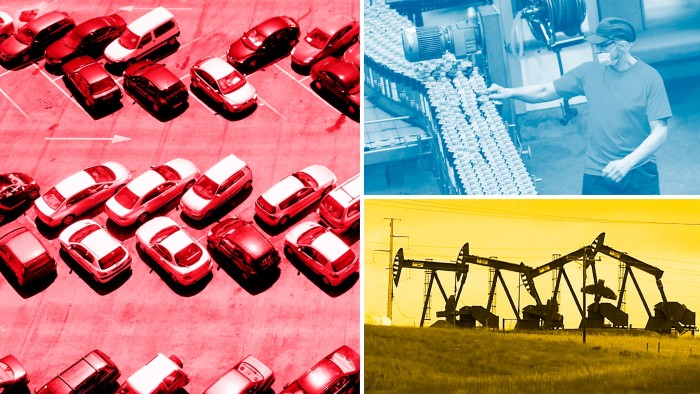Will the momentum in rising US consumer prices finally slow?

Simply sign up to the Commodities myFT Digest -- delivered directly to your inbox.
Will the momentum in rising US consumer prices finally slow?
US inflation is forecast to have risen in January once again. Economists polled by Bloomberg are betting that the consumer price index data to be released on Thursday will show year over year growth of 7.3 per cent, a fresh 40-year high.
But some analysts expect the pace of that growth to have moderated slightly, particularly in core goods like apparel and used cars.
Core CPI — which strips out the volatile energy and food components — is estimated to rise once again, but by 0.5 per cent month over month, compared to 0.6 per cent in December. The services side of core CPI, like medical expenses and rent, are not expected to fall. But analysts at Barclays say that the costs of clothes, new and used cars and alcoholic beverages — all part of the core CPI goods category — should have climbed less quickly than in December.
Used cars have been a significant driver of inflation throughout the pandemic. Because of supply chain bottlenecks, parts for new cars have been hard to get. With fewer new cars available, consumers turned to the used cars market, driving up prices. While those supply chain issues persist, Barclays notes that leading indicators like the Manheim used vehicles value index suggest prices may have peaked in October.
Will any of this change the Federal Reserve’s thinking about the need to aggressively raise interest rates? It is unlikely, given that inflation is still rising. But it may add some nuance to discussions about the direction of inflation later this year. Kate Duguid
Did UK GDP shrink in December after the emergence of Omicron?
The UK is forecast to have recorded the fastest economic growth since 1940 last year, as output rebounded from an unprecedented plunge resulting from tight coronavirus restrictions in 2020.
However, the good news is likely to be spoiled by an economic contraction forecast for December. Economists polled by Reuters expect UK output to have shrunk 0.5 per cent when the data is released on Friday.
Ellie Henderson, economist at Investec, also expects a dip — even though she thinks “the increase in health and social care output should partially soften the blow of the impact that the spread of Omicron had on the recreation sector.”
This is in line with the Bank of England’s latest forecast, which sees the level of GDP in the first quarter as similar to the fourth quarter because of a likely contraction in both December and January. However the bank noted that the economic impact of the Omicron coronavirus variant is expected to be “limited and of short duration,” with growth returning in February and March.
Output is forecast to have fallen in December despite only relatively minor social restrictions being imposed, because people changed their behaviour in the run-up to Christmas — resulting in falling retail sales and a deterioration in most measures of consumer spending.
There has also been some impact on labour supply, with some staff unable to work because of sickness or self-isolation, warned the BoE.
Economic growth is expected to nearly halve this year compared with 2021, according to the revised forecast by the Bank of England, which estimated that household disposable income will fall the most since 1990 this year as a result of surging inflation, rising taxes and more people losing their jobs. Valentina Romei
Is the US shale patch returning to growth mode?
Oil prices are surging. Producers are hauling in their biggest profits in years. And after a year of tight spending discipline, there are signs that America’s drillers are gingerly returning to the field.
After a decade in which the US shale patch pursued a growth at all costs strategy, burning through hundreds of billions of dollars in investor capital while barely managing to turn a profit, Wall Street has tightened the purse strings and enforced a new regime of capital discipline on the sector.
Scott Sheffield, chief executive of Pioneer Natural Resources, the shale patch’s biggest producer, describes a new “contract” between investors and operators, the terms of which demand a return of capital to shareholders instead of untrammelled growth.
But with Brent crude and West Texas Intermediate both now above $90 a barrel, private operators are leading a dash to put rigs back out in the field. And questions are growing over whether discipline among the big public operators can hold.
Investors will be closely watching as shale companies report their earnings over the coming weeks for indications of changes in growth plans. And the Baker Hughes rig count — up almost 60 per cent over the past year — will provide an insight of any acceleration in drilling. Myles McCormick
Comments